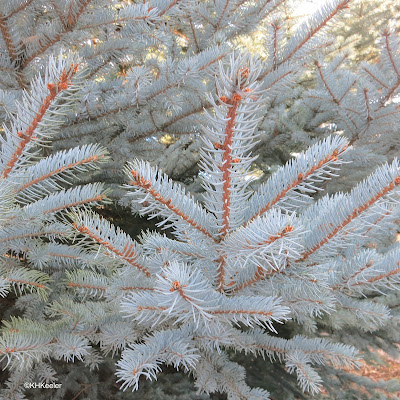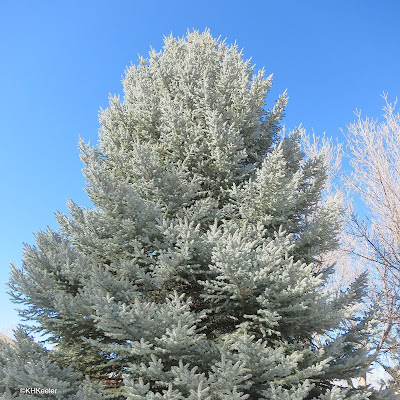Colorado blue spruce (Picea pungens, pine family Pinaceae) is native to the central and southern Rocky Mountains, in Idaho and Wyoming south to New Mexico and Arizona, from high elevations (USDA Zone 2) down to Zone 7 (lowest winter temperature, freezing). It is endemic to the United States. and more specifically, the Rocky Mountains. A beautiful tree with bluish foliage, it has been widely planted as an ornamental around the world.
 |
| Colorado blue spruce, Picea pungens |
In nature, Colorado blue spruces are often 75 feet high, and have reached 126 feet tall with a trunk 60 inches across (at 4.5' from the ground, the forester's dbh, diameter breast height). The literature reports that planted trees rarely get larger than 30-50 feet. I wonder about that. The oldest known Colorado blue spruce was 600 years old when it died. Experts estimate the trees could live to be 800. The species was discovered for western science by physician and botanist C. C. Parry in 1861 on Pike's Peak, and reported in 1862. Any planted blue spruce is younger than 159 years. So couldn't they grow larger for many more years?
My backyard is dominated by a towering Colorado blue spruce (below). I believe the builder planted it in 1973. Today it is probably 50' tall. It continues to get larger. I built a flagstone path through my flowerbeds about 10 years ago. Since then the spruce has expanded so that several of the flowerbeds are under it, and it is starting to send branches over my path. Why I thought it was through spreading I have no idea, but it certainly wasn't (isn't).
Colorado blue spruces start reproducing (producing cones) at about 20 years and continue for at least the next 100 years. Birds and small mammals eat the seeds.
 cones of Colorado blue spruce, Picea pungens, 3-4" long |
 |
| spruce forest (sorry, old photo) |
The growing conditions for Colorado blue spruces seem contradictory. They grow on mountain tops that get very cold, but the species range doesn't go into Canada, suggesting they don't do well in cold winters. Its natural stands are described as being in moist areas and yet it is the most drought-tolerant spruce and can endure periods of severe drought. It is described as both an early colonizer of disturbed sites and the forest dominant (climax species) taking over undisturbed sites from other trees. I can't sort this out from reading the literature. It all appears true. Certainly Colorado blue spruce prospers when planted, from southern Canada to Virginia, yet its natural distribution was limited to the central and southern Rockies and tended to be spotty there. What might link those observations? Perhaps seedlings are very sensitive but established plants are tough, or we're seeing odd patterns left by forest fires (it is easily killed by a forest fire) or because of some so-far-undefined soil requirement, or...there are many possibilities.
 |
| Colorado blue spruce, Picea pungens, foliage |
The beauty and symmetry of the tree has made them popular ornamentals, so you can find them all over the world. They have been embraced as Christmas trees. The U.S. National Christmas tree is a 30-foot Colorado blue spruce from Palmyra, PA (about it) Colorado blue spruce is the state tree of Colorado. This popularity represents success in the human-dominated world of today; the trees have a much-expanded population and worldwide distribution because humans like them, rather than being endangered because humans dislike or ignore them.
References
Coombes, A. J. 1985. Dictionary of Plant Names. Timber Press, Portland, OR.Fechner, G. H. Southern Research Service (SRS). Picea pungens Engelm. Blue spruce. link Accessed 12/24/2020.
Pavek, D. S. 1993. Picea pungens. In: Fire Effects Information System. (online). U.S. Department of Agriculture, Forest Service, Rocky Mountain Research Station, Fire Sciences Laboratory. link Accessed 12/24/2020.
Kathy Keeler, A Wandering Botanist
More at awanderingbotanist.com
Join me on Facebook: https://www.facebook.com/AWanderingBotanist


Thank you for this! I have some planted in my front yard a decade ago in response to the loss of both our fir, black, and white spruce to an invasive bark beetle introduced in 1999. The utility by wildlife is important and good to know, also the winter protection. I worry that they may be invasive themselves over time, but we don't know the future of the native trees...and now we are losing our beech too! So "thoughtful diversification seems key...I have since grown red pine and red spruce from seed and have younger trees of those coming along if the science determines I should remove them.
ReplyDeleteIt bears mentioning that the blue spruce is being attacked by a variety of diseases outside it's home range. In Ohio and other states with hot and moist climates blue spruces are dying off. Once infected, the trees will die because no economically feasible cure is known. Our Department of Natural Resources has advised residents to no longer plant this beautiful tree.
ReplyDeletehey what a beautiful tree! I would love to have one of these as a Christmas tree. sadly, I only see noble and Douglas firs in my area.
ReplyDelete